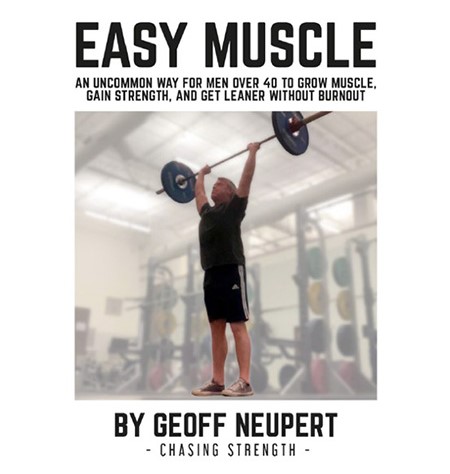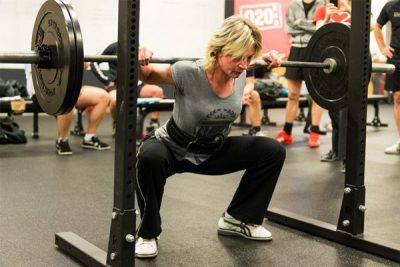
Do you remember when you started lifting weights?
I do.
My very first workout was a biceps workout with Chris Read, a senior, and the 140lb starter on the wrestling team, who was built like a mini-Ah-nold, at the base gym (RAF Lakenheath, England). I was a gangly, 15-year-old sophomore.
We did straight bar curls.
Preacher curls.
Alternating dumbbell curls.
And I’m not 100{32c02201c4e0b91ecf15bfd3deecd875caca8b9615db42cfd45ce3d8de8d0829} sure, because this was 1987, over 35 years ago, but I’m pretty sure we finished with concentration curls to hit the “peak.”
Every set was pushed to the limit—maybe a little more.
Lowering the weights e-x-t-r-a… s-l-o-w-l-y… to get the stretch.
I walked away from that workout head held high, a man among boys, I’ll tell you what, yessir!
The next morning was a different story:
I couldn’t move my arms. They were locked in place between slightly bent and 90 degrees.
When I saw Chris at lunch, he laughed hysterically.
I didn’t touch a weight again until April 1989, after I got my left arm out of a cast from breaking it while wrestling.
Then, I was fully “bitten” by the Iron Bug.
I trained at the base gym for the rest of the year and the entire summer, into the fall, while running Cross Country, to get in shape for my senior year of wrestling.
I ran for my heart, lungs, and my legs and did bodybuilding work for my upper body.
The result was a full 15 pounds of muscle—145lbs to 160lbs—between April and August of 1989.
My friends noticed. And the girls turned their heads, including Mara, the super-brainy co-captain of the cheerleading team, with a “Woooowwww!”
Everything a 16-year-old boy/young man dreams of. (Or almost everything.)
It’s these “first impressions” that we carry with us for the rest of our lives, indelibly burned into our brains.
To “get in shape,” you run.
To put on muscle, you work out like Ah-nold, and the rest of the bodybuilders in the 1960s, 70s, 80s, and 90s did.
Body part splits… chest & tris, back & bis, shoulders, legs—maybe, you are running after all…
Multiple exercises per body part:
- Bench
- Incline Bench
- Decline Bench
- Incline Dumbbell Fly’s (or Pullovers)
- Pec Deck (“… for your ‘Inner Chest’ Bro!”)
And every set pushed to failure, or beyond (“C’mon, Bro! One more! One more! It’s all you!”).
Our brains were, and may still be, infected by “Bodybuilding Ideology.”
You know I’m talking about you.
It’s why you still take every set to the max, by compressing your rest periods, even when you “know” you shouldn’t.
It’s why you eke out one more rep even when your technique has tanked, even when you “know” you shouldn’t.
So, let’s dig into what the research says about indulging our “Inner Bodybuilder” and get rid of this infection forever, shall we?
10 Reasons To Avoid Training To Failure (Like A Bodybuilder), Like The Plague
1. Training to failure suppresses your anabolic hormones
Testosterone and IGF-1, which build muscle and burn fat. [1]
2. Training to failure increases the nucleotide, AMP (Adenosine Monophosphate)
Which then signals a decrease in protein synthesis (muscle building). [2] The exact opposite of what we’re looking for.
3. Training to failure increases “central fatigue” [3]—that overall exhausted feeling
Which then decreases performance during your workout along with overall energy levels.
4. Training to failure increases cortisol production [4]
Too much circulating cortisol has been shown to increase stomach fat. [5]
5. Training to failure increases lactic acid (H+) in your bloodstream [6]
Which can lead to increased free radicals, which in turn damage your cell’s “powerhouses”—your mitochondria, making you age faster.
6. Training to failure leads to excessive muscular soreness and muscle damage [7]
Which decreases your insulin sensitivity, which means your body has a tougher time assimilating carbohydrates and increases your chances of storing them as fat.
7. Training to failure increases your chance of injury [8]
Because your technique changes from muscle exhaustion.
8. Training to failure often leads to overtraining [8]
Leaving you feeling always tired, emotionally drained, and physically present but emotionally absent.
9. Training to failure can cause insomnia or interrupted sleep
Which interferes with your body’s ability to recover from your workouts. Plus, lack of sleep increases body fat. [9]
10. Training to failure can deplete your most important muscle fibers
Your fast twitch fibers, from having chronically elevated cortisol levels. [10]
So, if training to failure like a bodybuilder is so bad, what should you do instead?
Since you’re reading this on the StrongFirst website, I’m guessing you know that the first thing you should do is never train to failure.
Instead, train like strength and power athletes:
1. Heavy-ish (for you),
And,
2. Explosively.
Light and middleweight weightlifters are great examples of the physiques most of us would “settle” for.
Use the Following Guidelines
1. Pick 2 to 4 “big” exercises
- Heavy, examples: Press, Squat, Pullup
- Explosive, examples: Clean, Swing, Snatch, Push Press/Jerk
2. Train between 65{32c02201c4e0b91ecf15bfd3deecd875caca8b9615db42cfd45ce3d8de8d0829} and 85{32c02201c4e0b91ecf15bfd3deecd875caca8b9615db42cfd45ce3d8de8d0829} of your maximum lift(s)
And rarely ever to a real max or to failure.
3. Keep your reps low
Between 1 and 3 or 4 to 7.
4. Train 3 days a week
And rest or do mobility/flexibility work on your off days, to help your recovery.
5. Keep your effort levels (Rate of Perceived Exertion—RPE) between a 7 and a 9
And always walk away “fresh” or feeling energized from your practices/ training sessions.
If you commit to training (“working out” in “Inner Bodybuilder” terminology) this way, you will rarely be sore, get incredibly strong, pack on an appreciable amount of muscle in all the right places, and remain relatively lean, assuming you don’t eat like a pig.
Happy Training!

for Men & Women Over 40
to Burn Fat and Build Muscle
in Just 90 Minutes A Week,
without Painful Dieting
To learn more about Easy Muscle e-book, CLICK HERE
References
[1]. https://www.ncbi.nlm.nih.gov/pubmed/16410373
[2]. http://journals.plos.org/plosone/article?id=10.1371/journal.pone.0040621
[3]. https://pubmed.ncbi.nlm.nih.gov/34881412/
[4]. https://journals.physiology.org/doi/full/10.1152/japplphysiol.01400.2005
[5]. https://pubmed.ncbi.nlm.nih.gov/32774535/
[6]. https://pubmed.ncbi.nlm.nih.gov/10023725/
[7]. https://builtwithscience.com/training-to-failure/
[8]. https://www.sciencedaily.com/releases/2022/03/220328165327.htm






